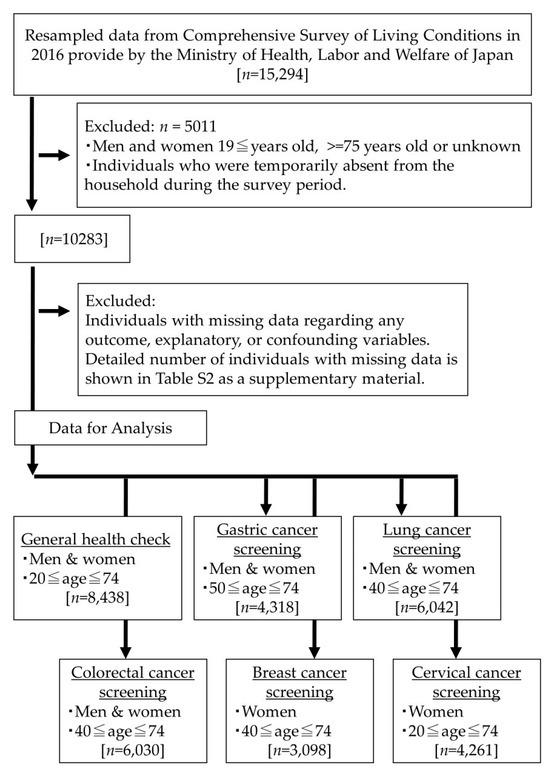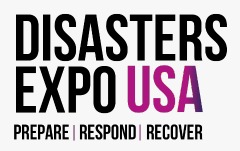
4.2. Association between Disability and Preventive Healthcare Service Use in Japan
Our study showed that disability was a significantly associated factor for non-participation in GHE and the screening of gastric, colorectal, breast and cervical cancer, controlling for 12 confounding factors. This finding implied that disability-based disparity may exist in preventive healthcare service use in Japan. This was our most notable finding.
Our findings were consistent with those of previous articles that examined disability as an associated factor for preventive healthcare service use. Andiwijaya et al. [
19] conducted a systematic review and meta-analysis and concluded that women with disability faced disparities in the reception of breast cancer screening (pooled adjusted OR: 0.78; (95%CI: 0.72, 0.85) and cervical cancer screening (pooled adjusted OR: 0.67; 95%CI: 0.47, 0.94) compared to women without disability. Moreover, a study [
43] analyzed cancer registration data (93,545 records from patients diagnosed with any type of cancer) from principal hospitals in northwestern Japan and reported that there was a significant difference in pathways for the detection of stage 0 or stage 1 cancer between people with and without disability. Specifically, people with disability with stage 0 or 1 cancer were diagnosed mainly through their regular hospital visits (44.9% and 54.5%, respectively), not through screening (14.7% and 9.4%, respectively). Conversely, their counterparts (people without disability) were diagnosed through cancer screening (31.4% and 24.2%) or regular hospital visits (34.3% and 39.6%, respectively). The study showed indirect evidence that the use of cancer screening can be disproportionately compromised owing to disability in Japan. Our findings supports the assumptions of previous studies and highlights the disparities in the use of preventive healthcare services in Japan.
We found no statistically significant association between disability and non-participation in lung cancer screening, which was unexpected. Admittedly, findings on disability as a potential barrier to for lung cancer screening use were mixed. A scoping review [
44] that focuses on barriers and facilitators to lung cancer screening use in the US reported supportive evidence that a patient’s “comorbidity” can be a potential barrier. However, another scoping review [
45] focused on behavioral barriers and facilitators to lung cancer screening from high-income countries and reported no disability-related behavioral barriers. Although the exact reasons were unclear, we speculated two possible explanations as to why only lung cancer screening was not associated with disability in our study. First, the procedure of lung cancer screening in Japan, specifically chest X-ray or sputum examination, might be easier or more acceptable for people with disability than other types of cancer screening. This might enable lung cancer screening to be more accessible for people with disability. Anecdotal and qualitative evidence [
46,
47] suggested that an individual with physical disability might face difficulties in undergoing cervical (Papanicolaou test) and breast cancer tests (mammography tests) as they require certain movements, such as moving on or transferring to a high examination table. Gastric (barium swallow test or endoscopic examination) and colorectal cancer screenings (fecal occult blood tests) may also involve some difficulty with procedures for people with disability during their examination. Conversely, lung cancer screening may involve relatively simple procedures, such as just standing in front of an X-ray machine or providing a sputum specimen. These relatively simple procedures might be attributable to the lack of an association between disability and non-participation in our study. Second, faulty recollection and overestimation of the experience of undergoing lung cancer screening might be factors in this lack of association. Lung cancer screening in Japan generally includes chest X-ray or sputum examination. These examinations, especially chest X-ray, are common examinations and are conducted for various purposes other than cancer screening (such as examination for pneumonia). Moreover, it is mandatory for some people who work in schools, hospitals or nursing care facilities to take an annual examination for the early detection of tuberculosis and prevention of its mass infection. Examinations for tuberculosis also include a chest X-ray. Therefore, individuals who worked in these facilities and underwent chest X-rays not aimed at cancer screening may have misunderstood and responded that they underwent lung cancer screening in the last year. Given that the CSLC was a self-reported questionnaire survey, misclassification can have occurred and influenced the results.
4.3. Reasons for Non-Participation in the General Health Examination
It is crucial to determine the reasons for non-participation to specify the barriers people with disability face and to envisage effective strategies. Therefore, we explored these reasons via the questionnaire item in the CSLC.
The two most dominant reasons were: I can go to see the doctor anytime, if I am worried (25/54, 46.3%) and I was admitted in hospital when the GHE was available (12/54, 22.2%). Thus, we conjectured that there might be some misconceptions regarding GHE among people with disability. First, even without any noticeable symptoms, GHE should be taken regularly for the early detection of diseases. If an individual realized their symptoms, felt anxious and went to see the doctor, it might be too late. Second, generally speaking, GHE was available anytime as a workplace-based or municipality-based examination in Japan. Even if there were periods of hospital admission, this might not compromise their opportunities to use GHE. If these misconceptions played roles as barriers that hindered access to GHE, campaigns or activities that aimed to spread accurate information and raise awareness regarding the health examination can be a solution to increase the participation rate among people with disability in Japan.
The third common reason (other than “other”) was I was too lazy to participate. Why were people with disability reluctant to participate in GHE? Potential barriers can include difficulty searching for an examination venue to accommodate people with disability, long waiting times, difficulty undergoing examination procedures and negative past experiences owing to disability-related issues. However, the specific barriers were unclear owing to the ambiguity of this option. Unfortunately, this ambiguity did not allow us to specify the barriers and envisage specific solutions. The necessity to enable specific answer options in the CSLC was implied.
The three most common reasons in this study included no reasons relating to the geographic/physical accessibility or affordability issues. These reasons were placed at a relatively at lower rank, fifth for affordability-related issues (“It was costly”, 5.6%) and ninth for geographic/physical accessibility-related issues (“Hospital for the examination was far”, 3.7%), respectively. The challenges or difficulties relating to geographic/physical accessibility or affordability, however, are reported to be common barriers for people with disability to access healthcare services [
13], especially in less resourced areas [
48,
49,
50,
51]. Maart S. [
48], for instance, investigated the use of health services among 152 people with disability living in a low-income area in South Africa. Their findings were that the main problems with accessing services included inadequate finances (71%) and transport problems (72%). Moreover, a literature review [
49] of 50 eligibles articles which examined access to general healthcare services for people with disability in low- and middle-income countries reported that “transport difficulties” and “financial difficulties”, as well as the “attitudes of staff”, were the most commonly reported barriers across the review articles. Contrary, a report from a well-resourced country, Australia [
50], indicated that difficulties or problems relating to cost or physical accessibility (3.6 to 12%) were not necessarily the most common issues with using healthcare services among people with disability. Instead, the issue of “unacceptable or lengthy waiting times” (24 to 31%) was a more common difficulty for them. Although a direct comparison between the findings of current study and the existing studies is impossible due to the heterogeneity of the study design and targeted health services, our findings were seemingly similar to the findings from Australia [
50], a well-resourced country. Although the geographic/physical accessibility or affordability issues should not be ignored, their relative importance or priority may be lower than other issues in a well-resourced country like Japan.
Last but not least, the answer option “other” was also a common answer option chosen in this study. Unsurprisingly, no concreate solutions can be made from this answer. This implied that the answer options in the CSLC questionnaire might not fully cover the barriers people with disability face and necessities the creation of more comprehensive answer options.
4.4. Implication for Future Studies Aiming to Eliminate Disability-Based Disparity in Preventive Service Utilization
This study implies that disability-based disparity may exist in preventive healthcare service use in Japan. This finding sheds light on the necessity to tackle this public health issue. We believe that our implications can contribute toward laying the groundwork for future studies aiming to eliminate disability-based disparity in preventive healthcare use in Japan.
First, our definition of disability was related to a self-reported necessity for support or supervision from others. This self-report-based definition may lead to misclassification, impacting on our study findings. Specifically, this definition may reflect some typical conditions, such as severe physical or intellectual disability. However, those who have other types of disabilities who do not necessarily need support from others, such as hearing impairment, vision impairment, minor developmental or physical disability, might not be represented in our definition. Moreover, those who need support but practically refuse or are unable to acknowledge it were not included as people with disability in this study, leading to underestimation. Contrarily, those who are healthy but temporally need some support due to temporary disabling conditions (e.g., fracture of the leg) might be included as people with disability, leading to over-estimation. This issue of misclassification was also reported in a previous study [
16] which used self-administered disability data. Although, our study findings implies a necessity to expand the research scope to a wider range of disabilities in further research, the disability-related data ideally should be corrected through reliable and validated data sources, such as a registry data source that includes diagnostic data on disability provided by medical professionals.
Second, although data from the CSLC provided good opportunities for researchers to examine the relationships between relevant factors, our study identified some drawbacks of the CSLC dataset for exploring reasons for non-participation. These drawbacks prevented us from obtaining relevant information on the barriers to GHE use among people with disability. Understanding specific and comprehensive reasons for non-participation in preventive healthcare services is crucial for creating concrete and effective solutions. Further studies aiming to specifically and comprehensively explore the reasons for non-participation in preventive healthcare services are necessary. Existing representative models [
52,
53,
54] of the associated factors for health service access may be helpful to gain a better understanding of specific and comprehensive barriers to preventive healthcare service use among people with disability in Japan.
Our team at Inergency is excited to announce our partnership with @Disasters Expo Europe, the leading event in disaster management.
Join us on the 15th &16th of May at the Messe Frankfurt to explore the latest solutions shaping disaster preparation, response and recovery.
To all our members, followers, and subscribers in the industry, This is YOUR opportunity to explore the intersection of sustainability and disaster management, connect with industry leaders, and stay at the forefront of emergency preparedness.
Don't miss out! Secure your complimentary tickets now and be part of the conversation driving innovation in disaster resilience. ➡️ https://lnkd.in/dNuzyQEh

And in case you missed it, here is our ultimate road trip playlist is the perfect mix of podcasts, and hidden gems that will keep you energized for the entire journey



